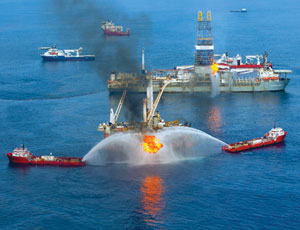Congress, engineers and oil industry executives have identified a list of flawed decisions made by BP and others—made under pressure to speed up work and reduce cost—that may be behind the April 20 fatal explosion that sank the Deepwater Horizon drilling rig.

The explosion killed 11 workers and led to the eruption of oil from BP’s Macondo well in the Gulf of Mexico.
“Time after time, BP had warning signs that this was, as one employee put it, a ‘nightmare well,’ ” said Rep. Bart Stupak (D-Mich) in opening statements during a June 17 hearing with BP CEO Tony Hayward. “BP made choices that set safety aside in exchange for cost-cutting and time-saving decisions,” he said.
Hayward denied wrongdoing and refused to cast blame, saying BP’s internal investigation is not yet complete. In Minerals Management Service and Coast Guard hearings, rig workers have denied that their work was compromised by pressure to finish the job.
BP itself, though, speculated in a May 24 briefing to Congress that the accident happened when its 97?8-in. casing around the well lost integrity, possibly because the float collar or seal assembly leaked, allowing gas to enter the well bore. The gas rose to the top of the well without being noticed. Two pressure tests led the crew on the rig floor to believe the well was sealed satisfactorily as they began displacing heavy drilling mud, used to contain the 13,000-psi pressure from the well, with seawater.
Between 8 p.m. and 9:10 p.m. on the night of the explosion, the crew noticed high unbalanced pressure in the well and then lost primary well control. Methane gas jetted water and mud through the riser pipe to the rig floor, where it shot several hundred feet into the air and was ignited—possibly by a source on a nearby boat or on the rig itself, according to a briefing rig-owner Transocean gave Congress.
A secondary means of control—the blowout preventer that seals the pipe or cuts it in half in case of a blowout—failed when activated at 9:56 p.m., according to testimony from a BP executive onboard the drilling platform at the time.
Engineers asked by the National Academy of Engineering to review the incident said the blowout was “caused by a complex and highly improbable chain of human errors coupled with several equipment failures” and was “preventable.”
Michael Norton, a drilling engineer consultant who has been hired by attorneys suing companies involved in the accident, told ENR that problems with the well began long before the explosion. The train wreck “was heading toward them, and they didn’t see it,” said Norton.
The subcommittee is focusing on five errors it believes were caused by a push to finish the well quickly and reduce costs. In a letter to Hayward, the committee detailed how BP workers, according to e-mails obtained by the subcommittee, departed from standard practices.
One area in question is the well’s design. Engineers chose a single string of casing, rather than multiple liners with a tieback. The choice saved $7 million to $10 million. On June 14, a group of oil company executives told the subcommittee the design increased the likelihood gas could travel to the surface. They said their companies would not have used it.
Also, instead of the 21 “centralizers” recommended by Halliburton, BP used only six to center the pipe in the well bore and ensure the casing cement flowed evenly around the pipe. Halliburton said with only seven centralizers, there was a “severe” risk of uncontrolled gas flow.
Installing the additional centralizers would have required an additional 10 hours of time. Other procedures called into question by the subcommittee include decisions not to run a test to check the completeness of the cement job, called a cement-bond log; the failure to run the mud from the top to the bottom of the well to ensure no gas was trapped in the mud; and the failure to secure the wellhead with a lockdown sleeve.
“Time after time, it appears that BP made decisions that increased the risk of a blowout to save the company time or expense,” Stupak and Rep. Henry Waxman (D-Calif.,) wrote in a letter to Hayward laying out the faults the subcommittee has found in its investigation.

Post a comment to this article
Report Abusive Comment